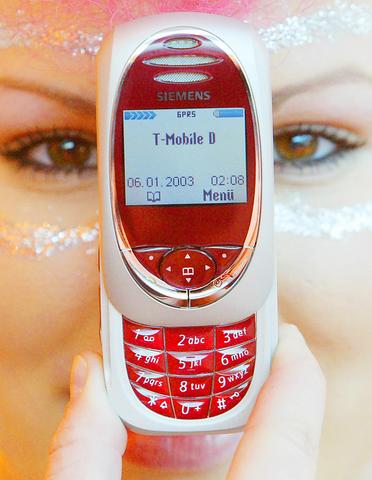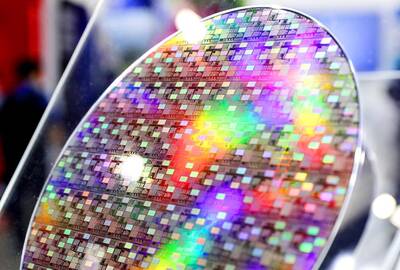Siemens AG, Nokia Oyj, Motorola Inc and Sony Ericsson Mobile Communications Ltd are among mobile-phone makers vying to gain market share in China, the world's biggest handset market, as growth slows elsewhere.
Siemens, the fourth-largest handset maker, aims to raise its share of the Chinese market to 10 percent from 4 percent. Nokia, the global market leader, wants to regain the top slot it lost to Motorola in the country last year. Sony Ericsson is targeting China to make up for lost market share in Europe and the US.
China "is a market nobody can ignore," said Gartner Inc analyst Ben Wood. "Growth there is spectacular."

PHOTO: REUTERS
In the past two years, China added on average two new mobile-phone subscribers every second, making it the fastest growing mobile market. Last year, it overtook the US as the world's No.1 cellular market, ending the year with 207 million handset users, more than the combined populations of Britain and Germany.
At this week's Cebit technology fair in Hannover, Germany, Siemens and rivals will be pressed by analysts to explain how they plan to build market share in China. Nokia, for instance, may introduce a follow-up handset for its 2100 phone, aimed at developing markets such as China, India and Russia, analysts said.
Handset sales in China will probably increase 14.5 percent a year through 2005, BNP Paribas Peregrine forecasts. Less than a sixth of China's 1.3 billion people own a mobile phone, compared with seven out of 10 Europeans and half of the US population.
Global mobile-phone sales rose 6 percent last year after falling for the first time ever in 2001, according to Gartner Inc.
Domestic handset makers' share of the market rose to 24 percent at the end of this year from 14 percent a year earlier, according to the Chinese government.
TCL Mobile Communication Co, Ningbo Bird Co and other local rivals are lifting sales by selling cheaper phones assembled from ready-made parts purchased abroad, analysts said. Some have also benefited from existing sales channels. TCL has more than 3,000 sales outlets throughout the country.
Bigger rivals have noticed. Timothy Chen, president of Motorola's China operations, last year called domestic rivals a "major threat." Nokia, Motorola and other foreign handset makers also have to adapt to local tastes, which differ from those in Europe and the US, executives and analysts said. The Chinese prefer hinged "clam-shell" phones, Sony Ericsson President Katsumi Ihara said.
They also want cheaper phones. The average Chinese worker earns in a year what it takes a US worker two and a half weeks to pull in.
"In China, the products required are quite different," Ihara said in a February interview. Therefore, Sony Ericsson will invest more in local research and development, he said.
A survey by Gartner found that Chinese handset stores carry more than 400 different products, Wood said. Siemens, which lost market share in China last year, is sponsoring the Chinese National Soccer League as the German company seeks to bolster its brand. Last year, it upgraded annual capacity at a Shanghai plant to 15 million phones from 11 million.
At the same time, Siemens is trying to steal a march on competitors by working with Chinese partners to develop a new mobile-phone system that, if chosen by the Chinese government, may threaten sales of Qualcomm Inc, Ericsson AB and other suppliers of equipment used for the current standards.
Siemens and Datang Mobile Communications Equipment Ltd, a company backed by the government, have spent more than two years developing the high-speed wireless technology, known as time-division synchronous code-division multiple access. The technology is now being tested in the city of Chongqing.

WAITING GAME: The US has so far only offered a ‘best rate tariff,’ which officials assume is about 15 percent, the same as Japan, a person familiar with the matter said Taiwan and the US have completed “technical consultations” regarding tariffs and a finalized rate is expected to be released soon, Executive Yuan spokeswoman Michelle Lee (李慧芝) told a news conference yesterday, as a 90-day pause on US President Donald Trump’s “reciprocal” tariffs is set to expire today. The two countries have reached a “certain degree of consensus” on issues such as tariffs, nontariff trade barriers, trade facilitation, supply chain resilience and economic security, Lee said. They also discussed opportunities for cooperation, investment and procurement, she said. A joint statement is still being negotiated and would be released once the US government has made

NEW GEAR: On top of the new Tien Kung IV air defense missiles, the military is expected to place orders for a new combat vehicle next year for delivery in 2028 Mass production of Tien Kung IV (Sky Bow IV) missiles is expected to start next year, with plans to order 122 pods, the Ministry of National Defense’s (MND) latest list of regulated military material showed. The document said that the armed forces would obtain 46 pods of the air defense missiles next year and 76 pods the year after that. The Tien Kung IV is designed to intercept cruise missiles and ballistic missiles to an altitude of 70km, compared with the 60km maximum altitude achieved by the Missile Segment Enhancement variant of PAC-3 systems. A defense source said yesterday that the number of

‘CRUDE’: The potential countermeasure is in response to South Africa renaming Taiwan’s representative offices and the insistence that it move out of Pretoria Taiwan is considering banning exports of semiconductors to South Africa after the latter unilaterally downgraded and changed the names of Taiwan’s two representative offices, the Ministry of Foreign Affairs (MOFA) said yesterday. On Monday last week, the South African Department of International Relations and Cooperation unilaterally released a statement saying that, as of April 1, the Taipei Liaison Offices in Pretoria and Cape Town had been renamed the “Taipei Commercial Office in Johannesburg” and the “Taipei Commercial Office in Cape Town.” Citing UN General Assembly Resolution 2758, it said that South Africa “recognizes the People’s Republic of China (PRC) as the sole

Taiwanese exports to the US are to be subject to a 20 percent tariff starting on Thursday next week, according to an executive order signed by US President Donald Trump yesterday. The 20 percent levy was the same as the tariffs imposed on Vietnam, Sri Lanka and Bangladesh by Trump. It was higher than the tariffs imposed on Japan, South Korea and the EU (15 percent), as well as those on the Philippines (19 percent). A Taiwan official with knowledge of the matter said it is a "phased" tariff rate, and negotiations would continue. "Once negotiations conclude, Taiwan will obtain a better